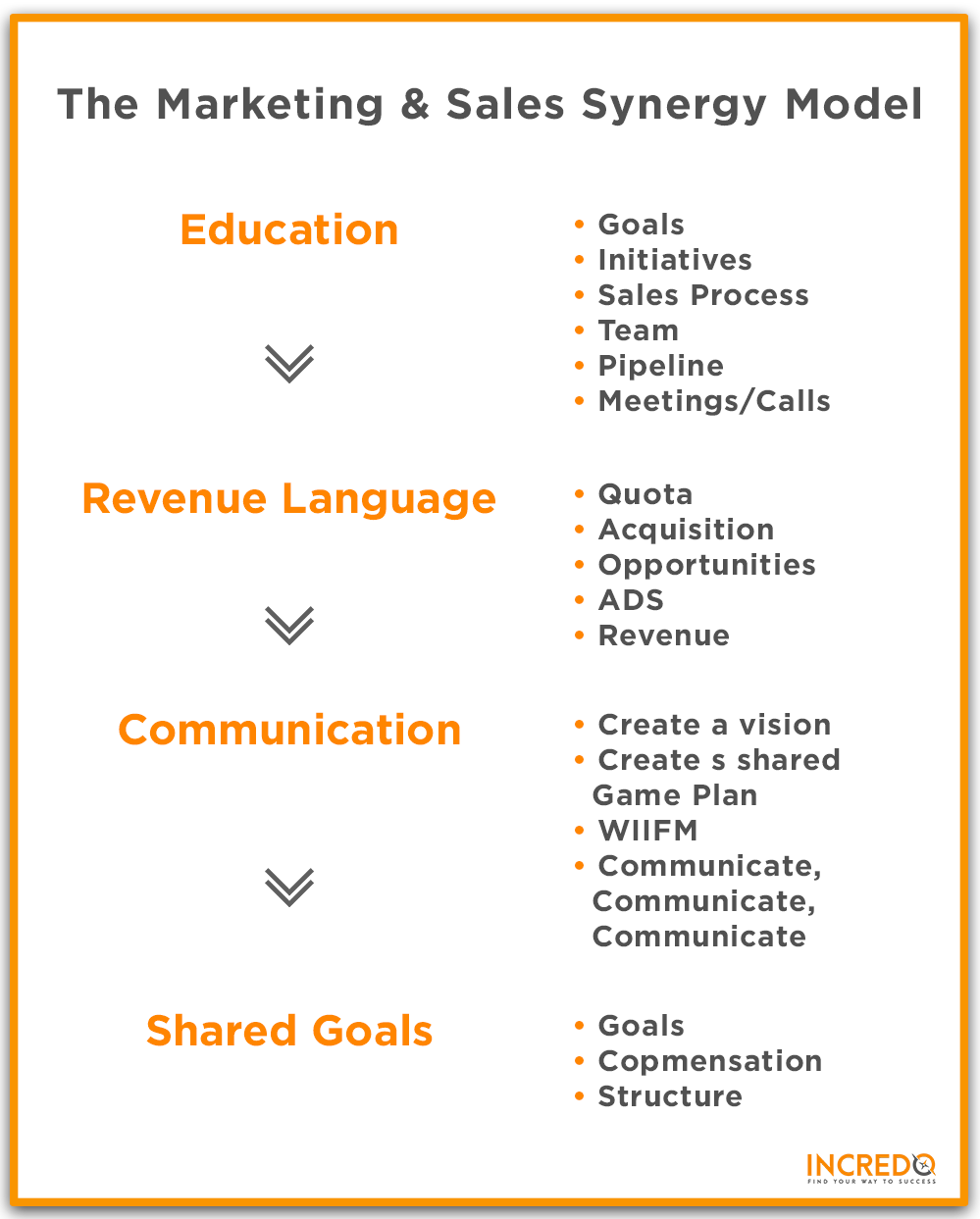Marketing and Sales Synergy Model for SaaS [2021]

Marketing and Sales Synergy Model for SaaS [2021]
Sales and marketing teams share almost identical goals: driving revenue, increasing profits and delighting customers. However, a lot of bigger companies in the SaaS industry have a real challenge of getting the two teams to actually work together and align their processes. The development of synergy between the sales and marketing is a growing focus in many organizations. Here’s why:As much as 80% of leads that are produced by the marketing team are never acted upon by a sales rep.
- According to the American Marketing Association, about 90% of selling content is never used in selling.
- According to CMO Council, salespeople spend around 40% of their time creating their own messaging and tools.
- Only 27% of the leads sent to salespeople by the marketing team are qualified first.
Pretty sad statistics, right? So, why is this happening? It is because of the absence of synergy between sales and marketing teams. In many SaaS companies these two teams are highly disconnected.
According to Kae Kronthaler-Williams, Global VP of Marketing for Exact, there are four important ways you can align sales and marketing for a positive impact on a company’s revenue:
1. Get sales onboard early – both the VP and the team. Working with a small group of salespeople will give you the chance to set examples of how the work should be done. If there are a larger number of sales personnel, bring in the managers to help share ideas, processes and insights into onboarding the sales staff.
2. Share relevant information, such as statistics, customer data, and organizational successes with sales team in order to build credibility.
3. Both sales and marketing teams need to be as transparent as possible in order to facilitate the working process and create trust.
4. Align KPI’s (key performance indicator) of the marketing team to the sales KPI’s and financial metrics. This really helps the collaboration begin and continue. They will see how many of their goals are aligned with one another.
In order to achieve the perfect sales and marketing alignment, you need to clearly understand their synergy model. Below is how marketing and sales synergy model typically works for SaaS companies.
The marketing and sales synergy model consists of four parts:
- Education
- Revenue Language
- Communication
- Shared goals
Let’s discuss each of them one by one. This is vital information for your company’s success, so we will try to be as clear as possible while not boring you to death.
1. Education
First of all, in order to create healthy relationships between sales and marketing, you need to educate your marketing team on all things related to sales. The reason is that you cannot simply create a marketing team relationship with sales without understanding their world, their way of thinking and their main activities. It really won’t work. So, in order to get into the sales world, you need to clearly understand what are their goals and key initiatives. Ask and then identify what is the sales process, who are sales team members, how does sales define their pipeline, what is their cadence of their internal meetings, customer calls and so on. Here are the 7 most important questions marketers should be asking their sales reps.
The best way to help marketers understand sales is through having them participate in sales meetings and sales calls. Once they begin to understand the sales team and their processes, your marketing team can begin to assist the sales staff with what matters the most to them: closing deals on leads.
2. Revenue language
Like sales, marketers should also begin embracing the language of revenue as per your SaaS company’s standards. In the brave new world of SaaS marketing, language of revenue is less about pretty fonts and printed slogans on mugs and more about driving revenue. Typical revenue marketers ask sales questions like: what number do you need for hitting your new acquisition target? What does your current opportunity pipeline look like and how we can help your team? What is your average deal size and how we can increase it? Why are opportunities not closing and how can we help you with them? Asking such questions and being involved in such processes will lead to faster sales cycles, bigger deals and, you guessed it, increased revenue. Those SaaS marketing teams that are aligned with their sales team can help accomplish these key metrics, because everybody is now on the same page as one another.
To create a hyperbolic example, imagine: what if the marketing team members had no idea of what the phrase ‘buyer’s journey’ meant whenever the sales team mentioned it? When the sales personnel mention that they do not have enough leads in the consideration phase of the buyer’s journey, what would the marketing personnel do? They simply would have no clue what is being referenced, and thus no idea of how to address the lack of leads in the consideration stage. While this was an extreme example, it underlines the point that shared company terminology between the sales and marketing teams is key for synergy to exist between them.
To get your marketing team speaking the revenue language, set up a series of 30-minute meetings and ask your sales team to make presentations on these topics for marketers. If your SaaS sales team covers each of these areas this will help you accomplish several things:
- Your sales team will feel more empowered
- The sales team will begin to connect with marketing team at the cognitive level
- The sales team can provide their views and share their opinions with the marketers without any barriers
- Your marketing team will clearly understand what is important to sales, and how to help increase revenue
- A relationship and two-way dialog between the two teams will grow
3. Communication
Once your SaaS marketing team starts to head down the revenue-boosting trail, the role of this team changes in the company as in how it begins to relate to the sales team and building revenue. As a leader in your company, in order to get ready for sales revenue-targeted marketing and in order to engage in a meaningful relationship with the marketing team, you need to have an effective vision and a game plan in place.
In a leadership position, it’s your responsibility when it comes to setting the vision, creating and communicating the game plan, collaborating with managers on refining the game plan and getting the teams to buy-in to your game plan. You need to clearly communicate the vision in order to make the sales team understand what’s in it for them, that you are making a plan not just for increasing the company’s revenue, but increasing their own as well .
Creating and getting commitment to a jointly developed game plan takes a good deal of time and repetition. You cannot just simply walk into a meeting and expect your sales team to fully and clearly understand your 30-minute presentation. You have probably spent months attending conferences, reading books and educating yourself about the benefits of revenue marketing. So, in order to communicate it to your sales and marketing teams effectively, you need to create a plan for multiple communication methods, meetings and events for sharing your vision and crafting the ultimate game plan. For example, you can set up a nurturing campaign based on company personas, such as VP of sales, sales team leader, etc. and nurture them with what revenue marketing is all about, why you need it and how well it is coming along in its development.
Here are 6 sales and marketing communication tips to build smarketing.
4. Shared goals
The importance of sales and marketing having shared goals, aligned compensation and complementary organizational structures cannot be ignored. In the SaaS sales world, no revenue accountability for marketing means ZERO respect from sales! If we take a look at the most successful revenue marketing machines, we can see that here the marketing team has the same kind of goals as the sales team. If the sales team has a number tied to new account acquisition, so does marketing. If the sales team has a number of enterprise accounts, so does marketing. If sales has a number for a new product, so does marketing, and so on.
You need to think about the goal alignment in terms of a maturity model. Based on the technology, processes and the people of your SaaS company, you can take a step-by-step approach to assigning KPIs to the marketing team. The natural procession of KPIs might look like this:
- Number of leads produced
- Percent of leads accepted by sales and the conversion rate of lead to SAL (Sales Accepted Lead)
- Number of opportunities created and the conversion rate of SAL to opportunity
- Percent of contribution to pipeline
- Percent of contribution to revenue
- The quota that aligns with the sales number.
Here are more 16 marketing KPIs to measure.
Following this simple model will help you create a real, working synergy between your SaaS’ sales and marketing teams. Have you ever used this model? Have you achieved that critical synergy between sales and marketing? What were your results? Share your experience and tips with us in the comments below. We would be happy to hear from you.
Tags:
SaaS Sales
November 9, 2020



Comments